
UNIVERSITY OF LEICESTER—The evidence for a new geological epoch which marks the impact of human activity on the Earth is now overwhelming, according to a recent paper by an international group of geoscientists. The Anthropocene, which is argued to start in the mid-20th Century, is marked by the spread of materials such as aluminium, concrete, plastic, fly ash and fallout from nuclear testing across the planet, coincident with elevated greenhouse gas emissions and unprecedented trans-global species invasions.
An international group of scientists is studying whether human activity has driven the Earth into a new geological epoch – the Anthropocene. They ask: to what extent are human actions recorded as measurable signals in geological strata, and is the Anthropocene world markedly different from the stable Holocene Epoch of the last 11,700 years that allowed human civilization to develop?
The Holocene Epoch has been a time during which human societies advanced by gradually domesticating the land to increase food production, built urban settlements and became proficient at developing the water, mineral and energy resources of the planet. The proposed Anthropocene Epoch, however, is marked as a time of rapid environmental change brought on by the impact of a surge in human population and increased consumption during the ‘Great Acceleration’ of the mid-20th century.
Dr Colin Waters of the British Geological Survey said: “Humans have long affected the environment, but recently there has been a rapid global spread of novel materials including aluminium, concrete and plastics, which are leaving their mark in sediments. Fossil-fuel combustion has dispersed fly ash particles worldwide, pretty well coincident with the peak distribution of the ‘bomb spike’ of radionuclides generated by atmospheric testing of nuclear weapons.” “All of this shows that there is an underlying reality to the Anthropocene concept”, commented Jan Zalasiewicz of the University of Leicester, a co-author and working group Chair.
The study, co-authored by 24 members of the Anthropocene Working Group, shows that humans have changed the Earth system sufficiently to produce a range of signals in sediments and ice, and these are sufficiently distinctive to justify recognition of an Anthropocene Epoch in the Geological Time Scale. In 2016 the Anthropocene Working Group will gather more evidence on the Anthropocene, which will help inform recommendations on whether this new time unit should be formalized and, if so, how it might be defined and characterized.
__________________________________________________
Composite image satellite view of earth at night, one visual indicator of how humans have changed the earth. Wikimedia Commons
__________________________________________________________________
A number of UK members of the group have contributed to this study, Colin Waters (lead author and Secretary of the group) and Michael Ellis, both from the British Geological Survey, Jan Zalasiewicz, Mark Williams and Matt Edgeworth from Leicester University and Colin Summerhayes from Cambridge University have provided significant input to this study and maintain the UK’s strong involvement in research into the Anthropocene concept.
Source: University of Leicester subject news releaseComposite image satellite view of earth at night, one visual indicator of how humans have changed the earth. Wikimedia Commons
__________________________________________________________________
*Colin Waters et al. (2016), The Anthropocene is functionally and stratigraphically distinct from the Holocene. Science.
__________________________________________________________________
In addition, the latest Popular Archaeology ebook is now available.
______________________________________________
Travel and learn with Far Horizons.
____________________________________________
This richly illustrated issue includes the following stories: Two remarkable discoveries that are shedding light on human beginnings in Africa; a traveling exhibit and an archaeological site that show how knowledge is more valuable than gold; a Spanish cave and a unique burial that are offering a tantalizing glimpse on the lives of Ice Age hunter-gatherers in Europe; the stunning visual reconstruction of an ancient Roman town; enlightening new finds at a remarkably well-preserved site of ancient Hellenistic-Roman culture overlooking the Sea of Galilee; rare finds that are shedding light on occult practices among ancient Greeks in Sicily; and an overview of the overwhelmingly rich archaeological heritage of Britain. Find it on Amazon.com.










